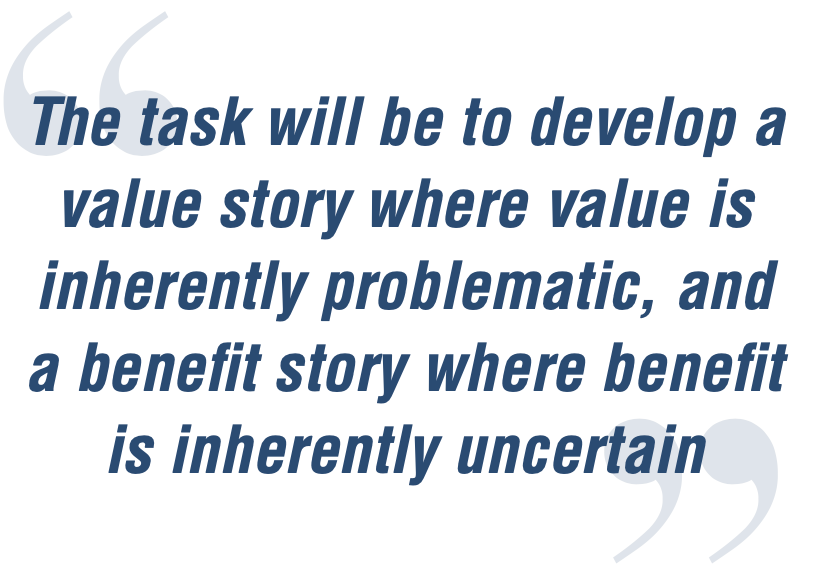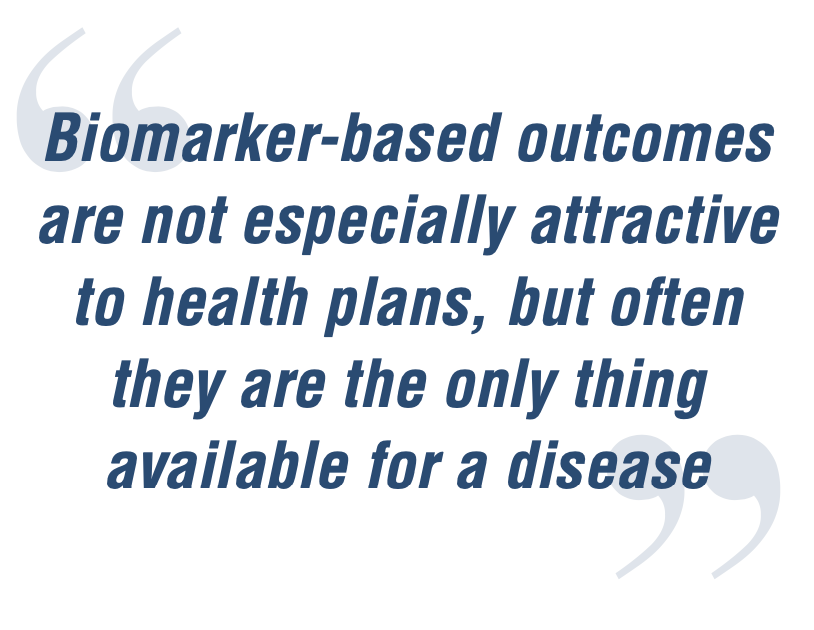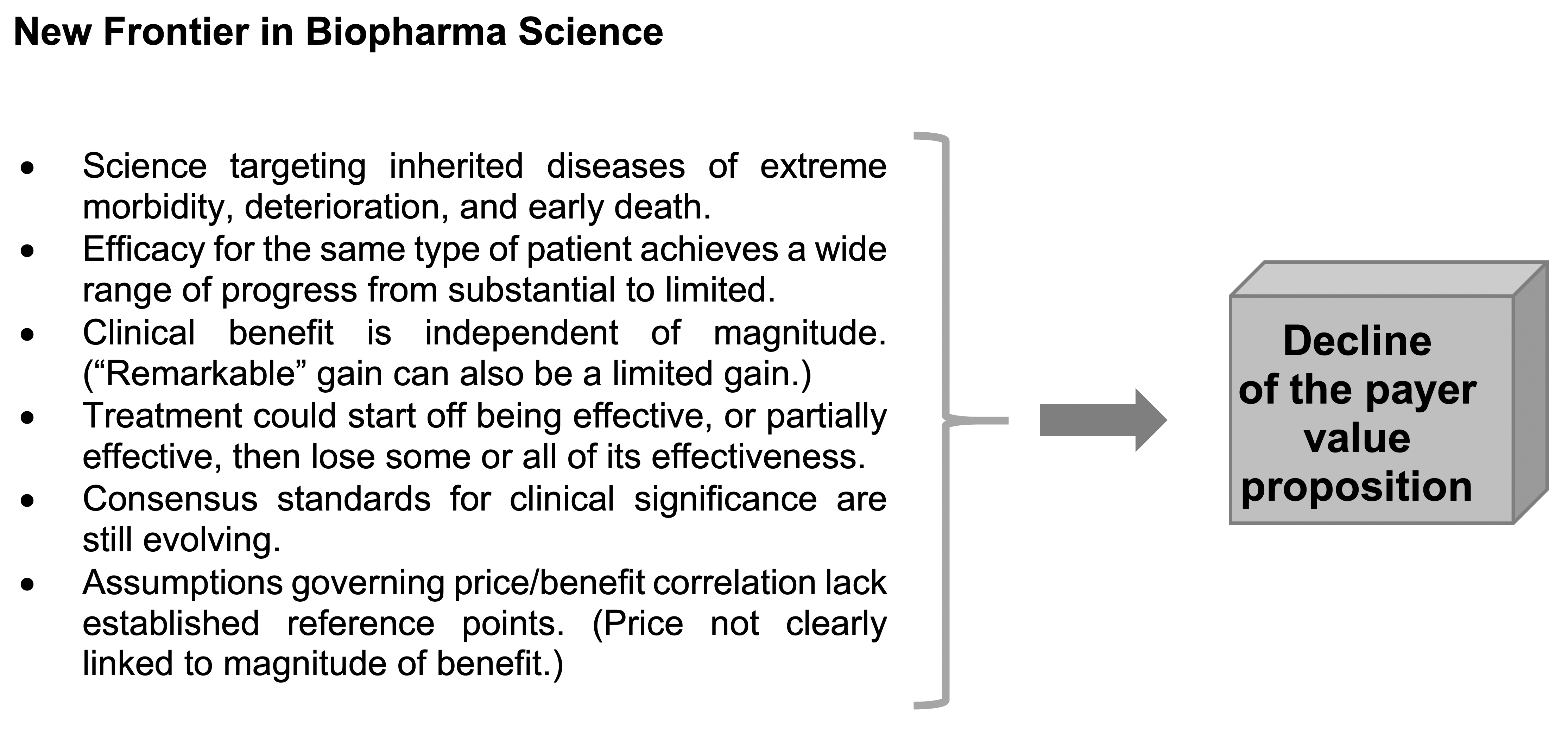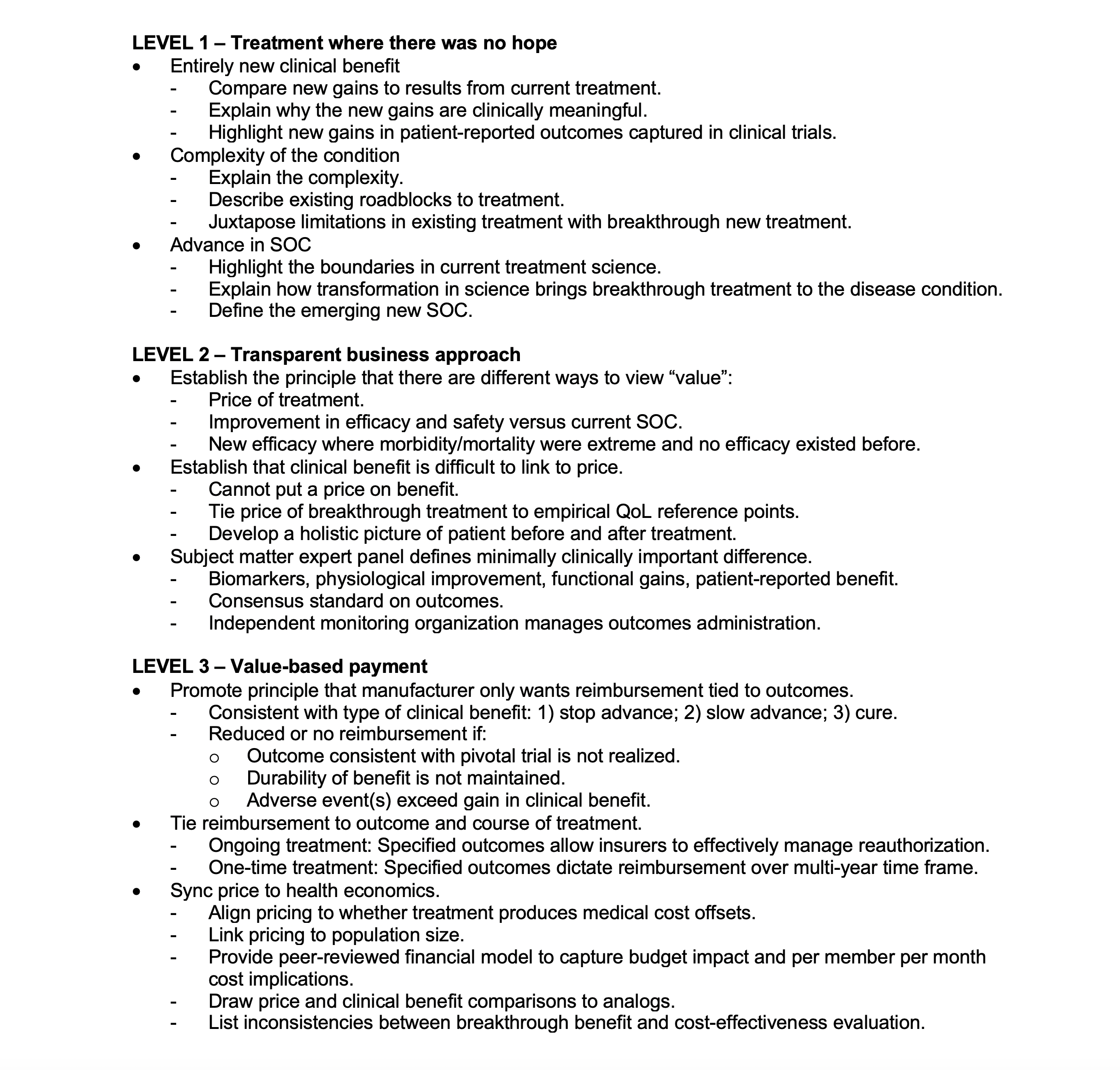‘Breakthrough’ Balancing Act: The Decline of the Value Proposition
How biopharma manufacturers can address extreme pricing of novel rare disease medicines and build legitimacy into commercialization to avoid an industrywide crisis.
Ira Studin, PhD

Experience suggests that value propositions in the pharmaceutical industry consist of two core elements: price on the one hand; clinical benefit on the other. Price is tied to clinical benefit. I will often conduct market research for manufacturers where the client wants insight into how payers view the value proposition of their Phase II or Phase III assets. Payers can’t address that question, however, because with the agent not on the market, there is no price. Where there is no price, there is no value proposition.
Examples of pharma value propositions might be: this statin has the lowest cost per percent LDL reduction compared to competitors; or this heart failure drug reduces hospital admissions at a lower cost than competitors; or, at the same cost for the same cancer, this treatment demonstrated 5% more patients achieving two-year progression-free survival than its competitor.
One theme developed in the discussion ahead is that with treatments for orphan diseases and rare cancers there is no competition and, by extension, no basis for making value proposition comparisons. In these situations, a vacuum exists. How that vacuum gets filled can impact the market for future breakthrough treatments.

A second theme is that for the growing percentage of breakthrough treatments for small populations at disproportionately high prices, clinical benefit is likely to be partial, with uncertain durability. Consequently, the task for manufacturers will be to develop a value story where value is inherently problematic, and a benefit story where benefit is inherently uncertain.
Both themes speak to challenges the pharmaceutical industry will need to contend with as transformative developments in biopharma advance the standard of care (SOC) for conditions where there is little hope for a favorable outcome. Both themes are also implicated in how payers can be expected to manage the health insurance dollar on which the pharmaceutical industry depends.
The first-half of this discussion provides a framework for understanding pure types of payer value propositions. The second-half makes the case that a new frontier in medical science, led by gene and cell therapy, is still in its infancy and not advanced enough for value proposition development.
The combination of extreme pricing and a value proposition vacuum has the potential to create a legitimacy crisis for the industry. To fill that vacuum, it is suggested that manufacturers build legitimacy into commercialization. Toward that end, a series of action steps are recommended in the conclusion.
Continuity in pharma value propositions
Value propositions for pharmaceutical brands are multi-layered and diverse. Where the spotlight shines, and what the decisive message is, can vary considerably. A strong value proposition for diabetes where there are multiple treatment options will differ from a strong value proposition for a rare cancer where there are few options. Unpacking the maze of variables produces a clearer understanding of the different types of value propositions and the shifting contours of value itself.
The suggestion here is that value propositions are created from two angles: composition and driving force. Composition of a value proposition is perhaps best understood as a continuum that starts with efficacy and ends with cost. In between are safety, tolerability, dosing, and route of administration.
Two axioms in the payer space leave their imprint on the continuum between efficacy and cost. First, payers don’t pay for convenience, minimizing the value of attractive dosing and administration. Second, decisions on safety and tolerability are considered the purview of physicians, minimizing judgements about the value payers attribute to these factors. Consequently, from a composition standpoint, there appears to be an underlying rule that payer perception of value will turn on how they weigh efficacy versus cost.
How does the weight of efficacy versus cost get sorted out?Based on my experience conducting pharmaceutical industry market research, it typically revolves around two foundational elements, unmet need and SOC, and gets shaped by how the interaction of those elements position efficacy and cost.
- Unmet need covers a range from comparable treatment options available to no other option with life and death in the balance.
- SOC covers a range from minimal new gain in efficacy to a clinically significant gain, reflected in valued outcomes.
The matrix illustrated in Figure 1 below describes the interaction between unmet need and SOC governing the priority given to efficacy and cost in payer value propositions. Off to the side, it pictures a new frontier in medical science, discussed further ahead.
Figure 1: Payer Value Proposition Matrix

Unmet need: Comparable options available
Looking at the left side of the Figure 1 matrix, when comparable treatment options are available, competitive conditions force manufacturers to elevate cost over efficacy. This behavior applies not only when a drug’s efficacy does not exceed SOC, but when efficacy does and produces a clinically significant improvement in outcomes.
Scenario A. Reformulated products—line extensions based on the same chemical entity—are perhaps the best example of efficacy not advancing SOC: a drug taken two times a day reformulated for once a day; or a drug administered once a day by self-injection reformulated for once a week. Regardless of improved convenience, the payer value proposition is cost-driven.
Even when conditions are life-threatening and a novel reformulation gives patients valuable new convenience, manufacturers are still forced to have cost drive its value proposition. The introduction of Ultomiris as second-generation replacement for Soliris illustrates this.
Soliris and Ultomiris are both approved to treat paroxysmal nocturnal hemoglobinuria, a rare and life-threatening blood disease. Knowing that a biosimilar for Soliris was in the pipeline, the manufacturer developed a PEGylated version of the original chemical entity, giving it a longer half-life. The latter extended the time between infusions, allowing patients to switch from every two weeks to every eight weeks. Nevertheless, it also determined that to avoid payers adopting a “Soliris-first” policy that would grow share for conversion to a future biosimilar, Ultomiris’ value proposition had to be cost-driven. This was reflected in pricing its maintenance dose roughly 10% below Soliris.
Scenario B. Moving up the Y axis, even with efficacy exceeding SOC and achieving a clinically significant improvement in outcomes, cost continues to prevail in the pharma value proposition. Direct-acting antivirals, widely seen as having revolutionized hepatitis C treatment, is a case in point.
Harvoni was the first in the therapeutic class to secure regulatory approval and, despite its extremely high price, quickly gained traction. Harvoni’s approval was followed two months later by Viekira Pak. While comparable from an indication standpoint, for multiple reasons, the market viewed Harvoni more favorably.
Significantly, however, a prominent payer moved quickly to contract with the lower-cost Viekira Pak, excluding Harvonifrom formulary. During that period, other payers signaled they would act similarly. Harvoni’s manufacturer saw first-hand the consequences of subordinating cost in its value proposition. Within months, Harvoni reversed value proposition priorities and went on to enjoy considerable success.
Unmet need: No other option with life and death in the balance
The relationship between cost and efficacy in the payer value proposition flips when unmet need shifts to no other treatment option with life and death in the balance. Under these conditions, competition does not exist. Here, the two boxes on the right in the Figure 1 matrix come into play.
Scenario C. Where unmet need is anywhere near having life and death consequences and the outcome is limited perhaps to a biomarker score with no other treatment option, efficacy supersedes cost in the value proposition. An example would be enzyme replacement for Gaucher disease. A senior clinical pharmacist in a market research study explained the logic this way:

“There is no true outcome from replacing the enzyme. It is a biomarker-based outcome. It’s not, ‘You were deficient. Now you have the enzyme and you’re reversing the symptoms that came from the enzyme not being there.’ Biomarker-based outcomes are not especially attractive to health plans, but often they are the only thing available for a disease. With ultra-orphan conditions where there’s nothing else, you pay hundreds of thousands of dollars because patients have no other option.”1
The operative principle is that even with limited benefit and cost to the extreme, if there is no other option, payers defer to the efficacy available. Introduce competition, and if the incumbent does not switch priorities in its value proposition, payers have the option of switching the product they cover. Action along these lines will likely escalate as biosimilar competition emerges.
Scenario D. With one exception, Scenario C is the same as this one—the exception being that treatment achieves a clinically significant improvement in outcomes and advances SOC. In both cases, absence of competition enables efficacy to trump cost in the value proposition. Where payers see incongruence between extreme pricing and benefit in Scenario C, extreme pricing registers differently in Scenario D.
Gleevec, first to market in the tyrosine kinase inhibitor class, is an older example of a novel cancer product that made a huge contribution to advancing SOC. More recently, Trikafta, a triple-combination therapy that helps a defective protein work more effectively in the treatment of cystic fibrosis, is a second example. Both agents can be considered breakthroughs and the efficacy each introduced allowed them to secure optimal access despite extreme pricing.
Once comparable options emerge, however, competition can take hold and efficacy is no longer the defining factor in the value proposition. As one respondent in a market research study put it when describing contracting opportunities in the oncology space: “An ideal situation is where there are multiple agents to treat the same indication with a similar mechanism of action. So PARP inhibitors for ovarian cancer and the CD4/6 inhibitors for breast cancer come to mind.”2
The impact of this structural dynamic in Scenario D appears likely to grow along two different paths. First, products enjoying market autonomy can expect to eventually face competition, prompting the need to adapt their value proposition accordingly.
As shown by the arrow pointing left in Figure 1 above, many breakthrough products facing competition could be forced to transition from the efficacy leverage they enjoyed under Scenario D to the cost leverage payers enjoy under Scenario B. Under these circumstances, contracting becomes a key function for incumbent brands.
The second path flowing out of Scenario D represents an entirely new scenario driven by the emergence of a new frontier in medical science. Gene and cell therapies operate on this second path. Unlike the first path, because of the complexities involved and the science being in its infancy, consensus standards that gauge the advance in SOC are early in their evolution.3
In addition, many of the disease states gene and cell therapies target are associated with little or no hope. It is here where we can expect to see the decline of the pharma value proposition.
Decline of the value proposition
The discussion so far assumes pharma R&D will continue to generate breakthroughs that start with efficacy-driven value propositions, face competition, and pivot to cost-driven value propositions. Where the market can anticipate a decline in pharma value propositions flows from a slice of R&D that generates products distinguished by a unique set of factors carving out a new frontier in biopharma science. These factors are noted in Figure 2 below.
Figure 2: New Frontier in Biopharma Science

The decline of the pharma value proposition is driven by a new frontier in medical science where efficacy introduced is inherently variable and price exceedingly expensive.
For breakthrough treatments emanating from this new frontier, there can’t be an efficacy-driven value proposition because the science is still in its infancy. And there can’t be a cost-driven value proposition because there is no competition. The combination of these two factors creates a vacuum for how to view the balance between efficacy and cost. How that vacuum is filled could have a major impact on investment capital for R&D focused narrowly on transformational gains in medical science.
One way to fill the value proposition vacuum is through cost-effectiveness—developing a dollar amount for cost per quality-adjusted life year (QALY) gained and cost per life year gained (LYG), then, drawing comparisons to determine whether treatment meets “a reasonable cost-effectiveness threshold.”4
Cost-effectiveness analysis is well-established, sophisticated, and has sought to accommodate the human element in evaluating treatment prices for rare, life-threatening diseases.
The difficulty with cost-effectiveness is that the new frontier of gene and cell therapies and other transformational treatments are not ready for mature economics. At various stages in their lifecycle, the underlying economics will shift. Early on, though, there is no equilibrium between cost, price, efficacy, and market share. Just as the science is new, the economics is as well.
What results is extreme pricing for rare diseases in super small markets. The problem for payers is the potential for a budget crisis. The problem for manufacturers is the potential for a legitimacy crisis.5
Legitimacy as a key business factor
Table 1: A Framework for Establishing Legitimacy (click to enlarge)

Until the new frontier of biopharma science begins to mature, the pharmaceutical industry will face growing questions about its legitimacy as a profit-making enterprise serving the public good.
The suggestion here is that if legitimacy is built into commercialization of breakthrough treatments early in their lifecycle, the industry will produce greater trust in its pricing.
The points noted in Table 1, found on the left, offer a multi-level framework for pharma to incorporate legitimacy into commercialization. Most of these points already exist in current practice. By building legitimacy into commercialization, manufacturers marry the idealism they bring to scientific discovery with value-driven standards they bring to business.
Rather than ceding the value proposition vacuum to cost effectiveness, legitimacy should fill that space instead. Better for biopharma pricing to establish legitimacy before cost-effectiveness shapes coverage and reimbursement. Better for an industry predicated on deploying capital at high risk to treat extremely complex diseases; and better for patients needing still-to-be developed miracles.
References
- 2019 payer interview.
- 2019 payer interview. PARB inhibitor brands are: Lynparza, Rubraca, Talzenna, and Zejula. CD4/6 inhibitor brands are: Ibrance, Kisqali, and Verzenio. Also, Zytiga and Xtandi (prostate cancer space) represent another example of competing cancer agents noted for having to contract to ensure market access.Instructive here is that while they share the same indication, payers will contract with one and disadvantage the other despite each having a different mechanism of action (Xtandi – androgen receptor inhibitor; Zytiga – CYP17 inhibitor).
- See, for example, “What are some of the challenges gene and cell therapies face?” From the American Society of Gene & Cell Therapy, https://www.asgct.org/education/more-resources/gene-and-cell-therapy-faqs.
- See, for example, executive summary p 40: http://icerorg.wpengine.com/wp-content/uploads/2020/10/ICER_SMA_Final_Evidence_Report_110220.pdf.
- A 2019 Gallup Poll measured how Americans viewed 25 industries. In that poll, the pharmaceutical industry scored last, well below the airline industry; https://news.gallup.com/poll/266060/big-pharma-sinks-bottom-industry-rankings.aspx. While the public’s view of pharma has improved due to the quest for vaccines and treatment for COVID-19, a Gallup poll conducted between July 30 and Aug. 12, 2020 has the pharma industry next to last, ranking only above the federal government; https://news.gallup.com/poll/319256/farming-rises-sports-tumbles-industry-ratings.aspx.
Ira Studin, PhD, President, Stellar Managed Care Consulting

Trump: 'Major Tariff' on Pharmaceuticals Coming Soon
Published: April 9th 2025 | Updated: April 9th 2025“We’re going to tariff our pharmaceuticals, and once we do that, they are going to come rushing back into our country," President Donald J. Trump said during a Tuesday night dinner in Washington.
ROI and Rare Disease: Retooling the ‘Gene’ Value Machine
November 14th 2024Framework proposes three strategies designed to address the unique challenges of personalized and genetic therapies for rare diseases—and increase the probability of economic success for a new wave of potential curative treatments for these conditions.